
Virginia has a long history dating back thousands of years to the indigenous tribes that live there. More recently, it became the first permanent English colony in the Americas and has gone on to feature prominently in the United States’ history. The state, also known as “Old Dominion,” also has a rich natural history. You can find many kinds of plants and animals in Virginia, ranging from ospreys to foxes. Virginia also features many different kinds of spiders. From crevice weavers to wolf spiders, you can find all sorts of spiders in Virginia. Here is a list of 10 spiders that call Virginia their home.
#10. Black Lace Weaver
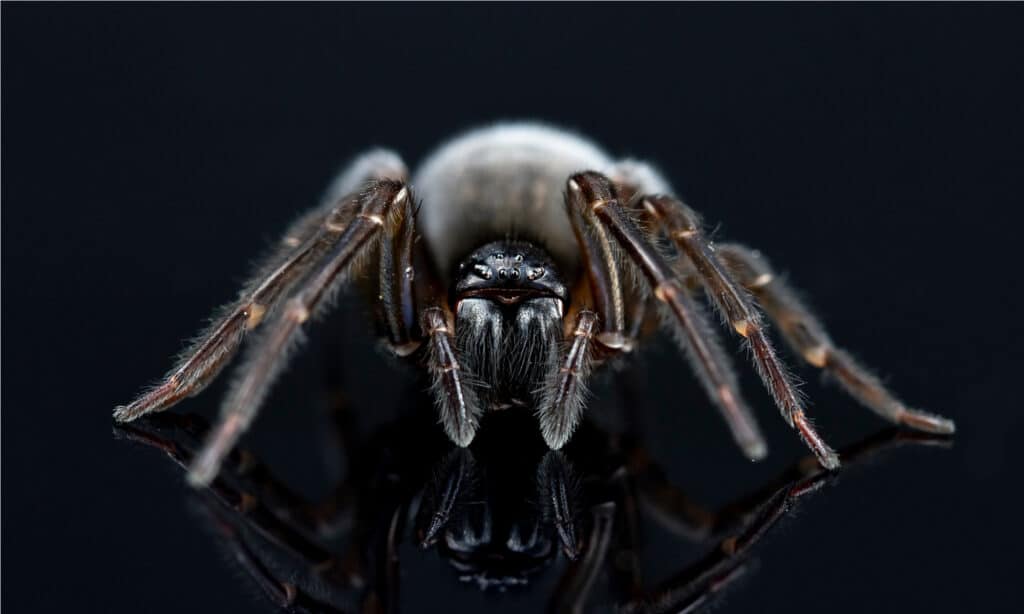
The black lace weaver’s web looks almost like lace.
©IanJHall/Shutterstock.com
The black lace weaver, Amaurobius ferox, belongs to the three-clawed cribellate spider family Amaurobiidae. It originally hails from Europe but now ranges throughout much of the United States and New Zealand.
Adult female black lace weavers usually measure from 11 to 16 millimeters long, and males measure 8 to 10 millimeters long. As their name implies, they appear primarily black but can vary in color from dark red to brown. That said, these spiders typically sport a pale yellow marking shaped like a skull on top of their abdomen.
If you want to find black lace weavers in Virginia, you should look in dark, damp places such as cracks in walls or under stones. They make cribellate webs of thin, sticky threads. Their silk possesses an almost wool-like texture that makes it look similar to lace, hence their name. These spiders have a bite that poses no danger to humans.
#9. Striped Fishing Spider
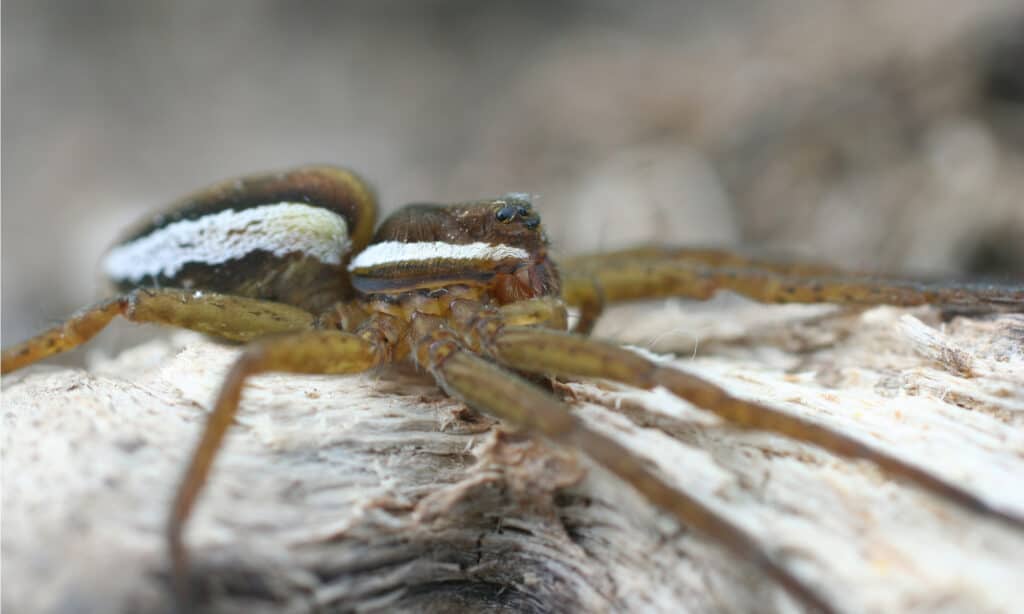
The striped fishing spider can run on water or dive to capture prey.
©Oleg Nikonov/Shutterstock.com
Dolomedes scriptus, known as the striped fishing spider, belongs to the fishing spider family Pisauridae. You can find this spider in Virginia as well as throughout much of the United States and Canada.
Female striped fishing spiders can reach nearly 2.5 centimeters long. On the other hand, males measure significantly smaller than females. They look predominantly light brown but vary in color from grey to tan. A thick tan or white stripe runs along both sides of the body, and they sport dark W-shaped markings on the abdomen.
Striped fishing spiders spend most of their lives living along streams, ponds, lakes, or other bodies of water. They don’t rely on webs to capture prey. Instead, they use their legs as fishing lures to snatch insects and fish from the water. In addition, these spiders can run across the water’s surface or dive into the water to catch prey.
#8. Southern House Spider
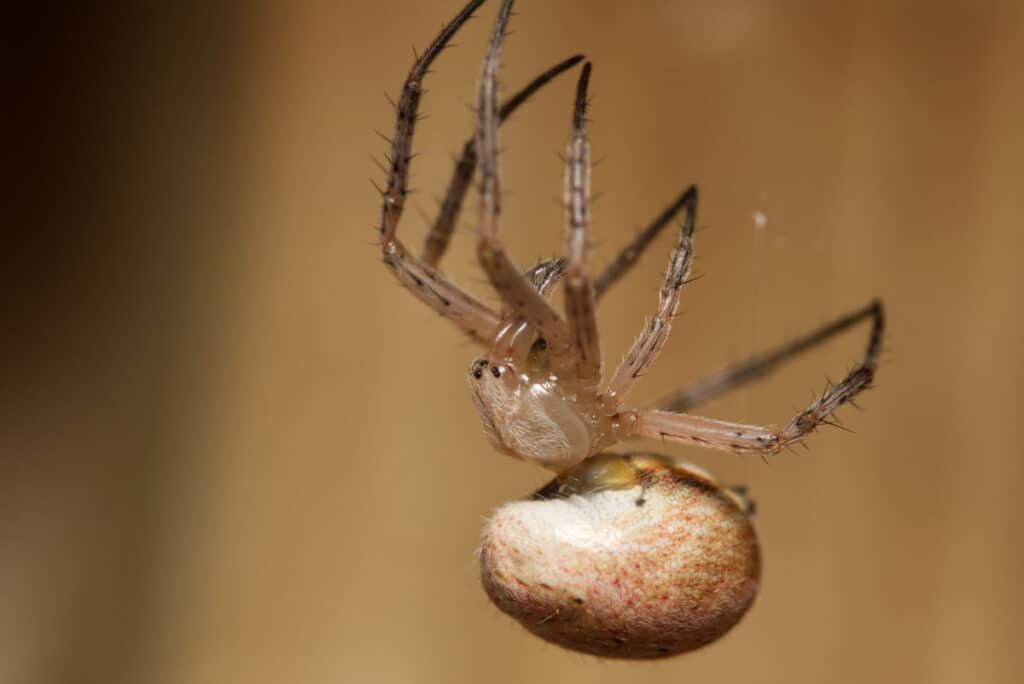
Southern house spiders often get mistaken for brown recluses due to their similar markings.
©Kala Stuwe/Shutterstock.com
The southern house spider, Kukulcania hibernalis, belongs to the crevice weaver spider family Filistatidae. It ranges throughout the southern United States, South America, and the Caribbean and is one of the most common spiders in Virginia.
Adult southern house spiders can measure up to 5 centimeters long with their legs extended. Females and males measure roughly the same size. However, males usually have longer legs, while females possess larger bodies. These spiders appear predominantly brown, with males generally looking lighter in color than females.
Southern house spiders often live in or near human buildings, which is where they get their name. They build radial-style webs made of non-sticky threads that they use to catch their prey. Generally speaking, these spiders don’t act aggressively toward humans, and their bite is not medically significant.
#7. Magnolia Green Jumper

The magnolia green jumper gets its name from its bright green color and amazing jumping ability.
©iStock.com/RobertDowner
Lyssomanes viridis is more commonly known as the magnolia green jumper. A member of the jumping spider family Salticidae, it ranges throughout the southeastern United States and Central America.
Adult female magnolia green jumpers usually measure 7 to 8 millimeters long, while males measure 5 to 6 millimeters long. They get their name from their characteristic pale, practically translucent green color. They sport either red, orange, or yellow scales on top of the head and numerous dark spots on the abdomen. Their legs are longer in proportion to their body size than most other jumping spiders. Like other members of their family, these spiders possess large mouthparts and eyes.
If you want to find magnolia green jumpers in Virginia, your best bet is to look on or around magnolia trees. They can’t leap as far as some other jumping spiders, so they prefer to ambush their prey from behind. Their bite is not medically significant.
#6. Labyrinth Orb Weaver
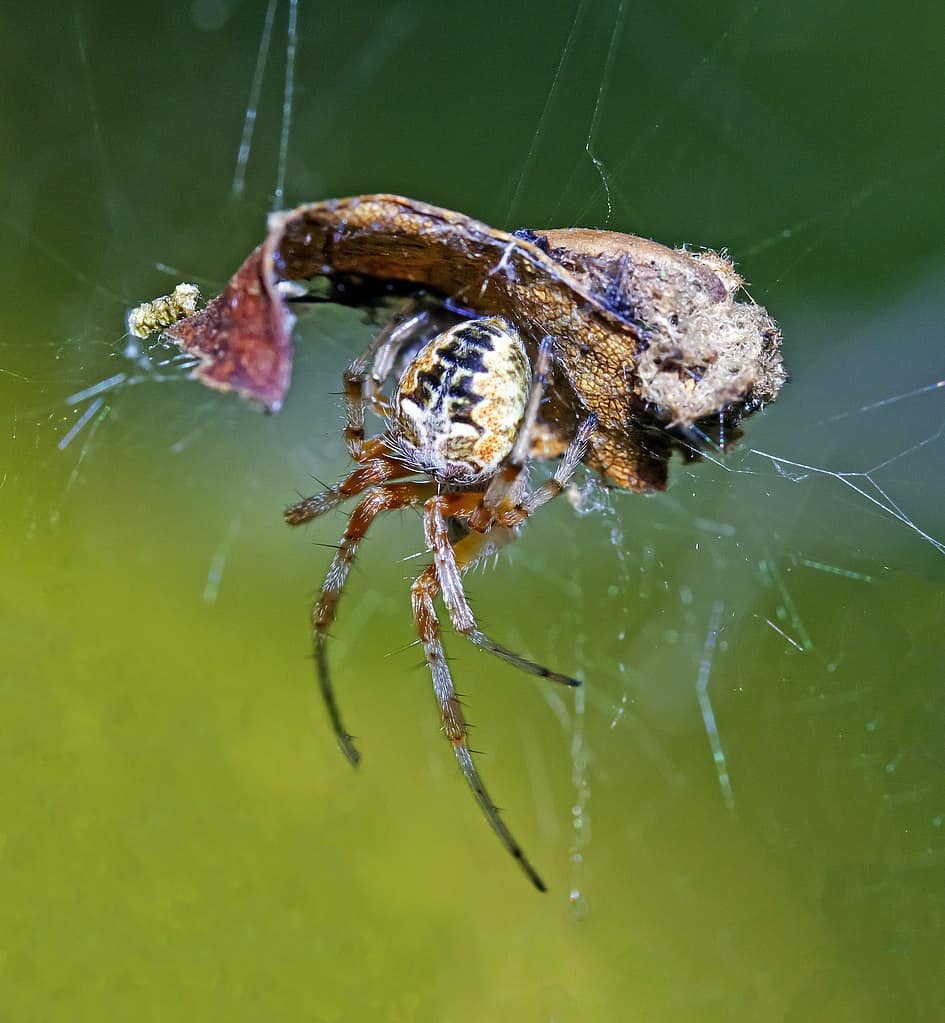
The labyrinth orb-weaver builds a web consisting of both an incomplete orb and a tangled cobweb.
©WanderingMogwai / CC BY-SA 4.0, via Wikimedia Commons – License
The labyrinth orb weaver, Metepeira labyrinthea, is a member of the orb-weaver family Araneidae. You can find this spider in Virginia and throughout the United States, all the way south to Argentina.
Female labyrinth orb weavers measure only up to 5 millimeters long, while males measure slightly smaller. They possess a bulbous abdomen and thin, long legs. The carapace appears either brown or grey, while the abdomen looks dark with white markings. Light hairs surround the area around the eyes, and they feature a white median line along the sternum.
Labyrinth orb weavers make webs very different from other members of their family. They spin incomplete orb webs made of both an orb designed to catch prey and a tangled web behind that serves as a shelter. Due to their small size, these spiders have a bite that poses no threat to humans.
#5. Broad-Faced Sac Spider
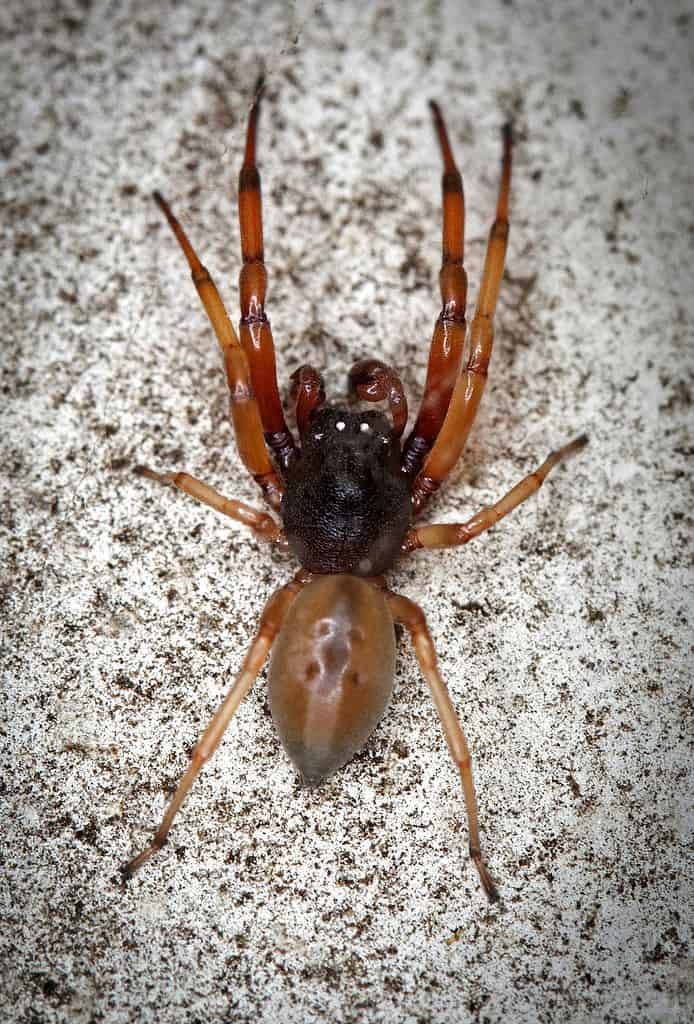
The broad-faced sac spider will willingly scavenge for dead spiders and insects.
©WanderingMogwai, CC BY-SA 4.0 <https://creativecommons.org/licenses/by-sa/4.0>, via Wikimedia Commons – License
Trachelas tranquillus, or the broad-faced sac spider, is a member of the ground sac spider family Trachelidae. You can find it throughout most of the central and eastern United States, along with parts of Canada.
Adult female broad-faced sac spiders measure between 7 and 10 millimeters long, while males measure 5 to 6 millimeters long. The carapace and chelicerae look reddish-brown. Meanwhile, the abdomen can range in color from light grey to yellow, and the legs appear reddish-orange.
Broad-faced sac spiders hide in silken retreats during the day and then emerge at night to hunt for food. Interestingly, they will often eat dead insects, unlike most other spiders in Virginia. While not normally medically significant, bites from these spiders can be quite painful. The greatest risks usually stem from secondary infections if bites don’t receive treatment.
#4. Southern Black Widow
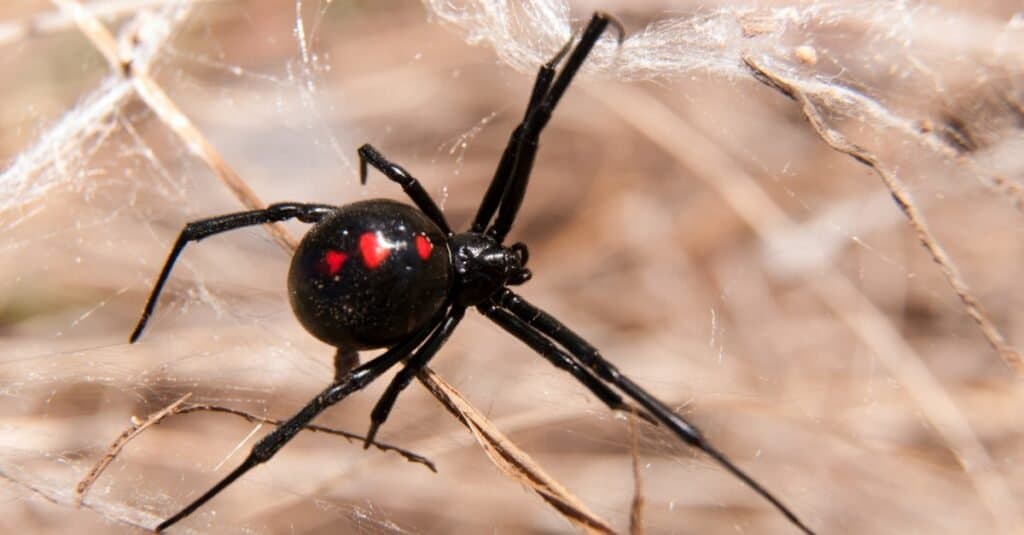
Black widow spider bites rarely kill people, but it’s important to get medical attention as soon as you can.
©Sari ONeal/Shutterstock.com
The southern black widow, Latrodectus mactans, is one of the most poisonous spiders in Virginia. It also goes by the name “shoe-button spider” and ranges throughout much of southern North America.
Adult female southern black widows typically measure between 8 and 13 millimeters long, while males measure 3 to 6 millimeters long. They appear primarily black aside from a characteristic red hourglass-shaped marking on the dorsal side of the abdomen. Additionally, they often feature a red or orange-colored patch above the spinneret on the ventral side of the abdomen.
Female southern black widows are notorious cannibals that will often kill and cannibalize males shortly after mating. They build tangled cobwebs that they use to capture not only their prey but also their mates. These spiders have a venomous bite that possesses powerful neurotoxins that can cause latrodectism. Common symptoms include pain, muscle aches, difficulty breathing, and nausea.
#3. Rabid Wolf Spider

Rabid wolf spiders are harmless to humans, but larger specimens can give a painful bite.
©Brett Hondow/Shutterstock.com
Rabidosa rabida, or the rabid wolf spider, is a member of the wolf spider family Lycosidae. You can find this spider in Virginia and throughout the eastern United States.
Female rabid wolf spiders measure between 16 and 21 millimeters long, while males measure about 13 millimeters long. That said, some females can grow up to 25 millimeters long. They appear primarily yellow except for two dark brown stripes along the cephalothorax and one dark stripe in the middle of the abdomen. Their name stems from their sporadic movements, which make them appear as if they are rabid.
Rabid wolf spiders do not use webs for catching food. Instead, they are active hunters that either ambush or chase down their prey. Their bite is not medically significant despite their large size and ferocious-sounding name.
#2. Regal Jumping Spider
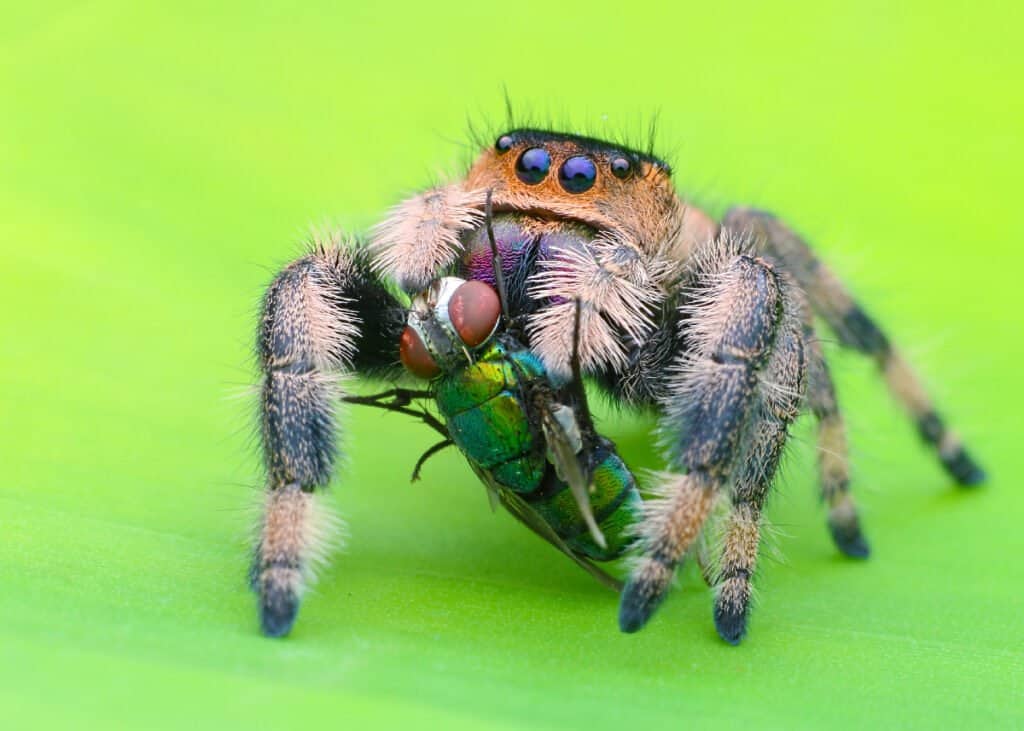
The regal jumping spider is the largest species of jumping spider found in the eastern United States.
©Farid Irzandi/Shutterstock.com
The regal jumping spider, Phidippus regius, is the second member of the family Salticidae to make our list of spiders in Virginia. It is one of the largest jumping spiders in the United States and ranges throughout the eastern half of the country.
Female regal jumping spiders measure between 7 and 22 millimeters long, and males measure 6 to 18 millimeters long. On average, females range in color from orangish-red to grey, while males typically look black with white spots and stripes. However, both sexes sport three dots on the abdomen in the shape of a smiling face.
Regal jumping spiders do not use webs to catch their prey. Instead, they rely on their keen eyesight and amazing leaping ability to attack prey from afar. While they pose no danger to humans, their bite can be moderately painful. These spiders are normally quite docile and therefore make popular pets.
#1. Banded Garden Spider
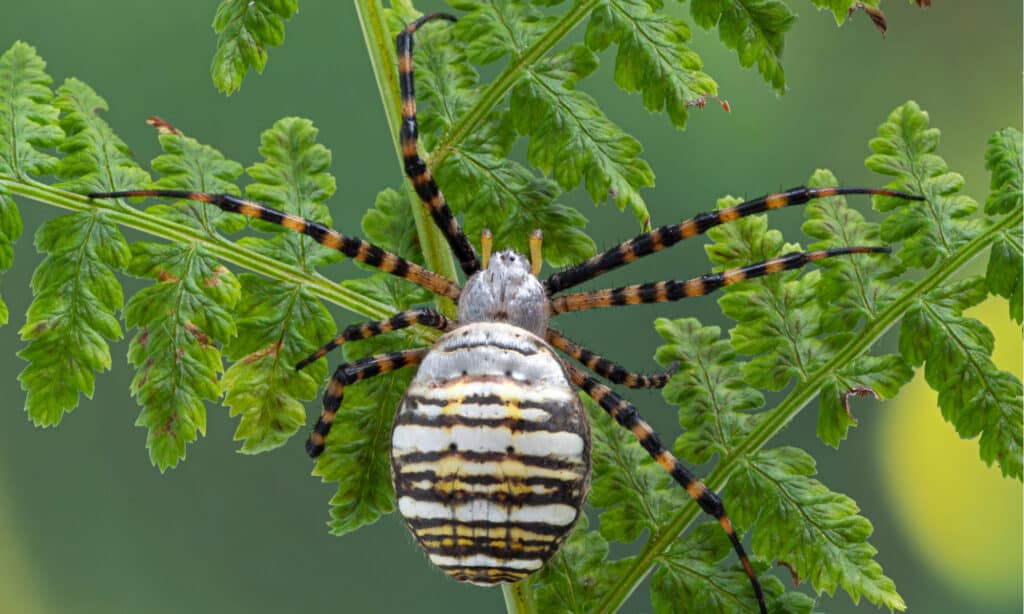
The banded garden spider features alternating black and yellow stripes.
©Ernie Cooper/Shutterstock.com
Argiope trifasciata, or the banded garden spider, is one of the most common spiders in Virginia. A member of the Araneidae family, you can often find it in gardens and fields throughout the state. Although it hails from North and South America, you can now find it worldwide.
Female banded garden spiders measure between 15 and 25 millimeters long, while males measure 4 to 5 millimeters long. The top of the abdomen appears white except for its alternating yellow and black bands. Meanwhile, the bottom of the abdomen looks mostly yellow, aside from a wavy brown stripe down the center. Additionally, their legs sport alternating orange and black bands.
Banded garden spiders weave orb-shaped webs that can reach nearly two feet wide. Females often hang upside down in the center of their webs while waiting for prey. Despite their large size, their bite is not medically significant.
Summary Of 10 Spiders In Virginia
| Rank | Spider |
|---|---|
| 10 | Black Lace Weaver |
| 9 | Striped Fishing Spider |
| 8 | Southern House Spider |
| 7 | Magnolia Green Jumper |
| 6 | Labyrinth Orb Weaver |
| 5 | Broad-Faced Sac Spider |
| 4 | Southern Black Widow |
| 3 | Rabid Wolf Spider |
| 2 | Regal Jumping Spider |
| 1 | Banded Garden Spider |
The photo featured at the top of this post is © Lukas Jonaitis/Shutterstock.com
Thank you for reading! Have some feedback for us? Contact the AZ Animals editorial team.







